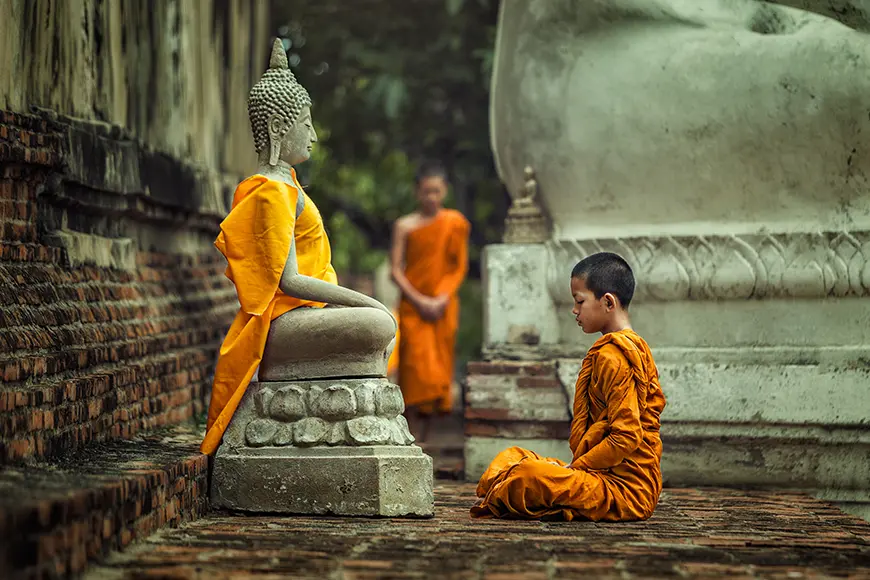Psychology•September 15, 2025
Mahayana Buddhism: Origins and Meaning
Mahayana Buddhism is a unique and popular religious doctrine from Asia. The uniqueness of Mahayana Buddhism lies in its teachings that emphasize ideas such as that the true nature of all things is emptiness and that every single thing is dependent on everything else.
Read on to learn more about the origins of Mahayana Buddhism and its teachings. You will also find out who started the whole Buddhist religious movement and about the Buddha Amitabha, who vowed to help all those who have faith in him end samsara and join him in paradise.
Mahayana Buddhism - A shared effort toward awakening
Buddhism started with the realization of one man, that life is suffering, and our desires keep us attached to the illusory, transient moment.
The man achieved enlightenment, which came in the form of four noble truths, freeing him from the illusion of desires and everlasting suffering. He found the middle way between extreme asceticism and enslavement to sensory attachments, a path known as the Eightfold path.
This man was named Siddartha Gautama, a famous historical buddha who inspired hundreds of millions of people to see the true nature of the world, free themselves of suffering, and follow a path toward enlightenment.
Before Siddartha’s realization, it was believed that people would need multiple reincarnations to have a chance of reaching enlightenment. However, he showed and preached that enlightenment could be achieved in a single lifetime by anyone willing to do it. He gave people hope and a way to change their lives by sharing his wisdom.
The meaning and origins of Mahayana Buddhism

Mahayana Buddhism teaches us to be selfless and compassionate because we are all connected.
Meaning
Mahayana Buddhism is a term from Sanskrit that is translated as the "great vehicle," and it refers to a wide range of Buddhist teachings and practices. Mahayana tradition teaches people that a path that leads to their awakening is a path toward the awakening of all sentient beings because there isn’t a real self.
Origins
The story of the first Buddha
Buddhism starts with the story of Siddartha Gautama, a Hindu prince that was supposed to take over his father’s kingdom.
When he was born, a seer delivered the prophecy that if Siddartha experienced or even saw evidence of suffering or pain, he would become one of the greatest spiritual leaders renouncing his kingdom.
His father tried sheltering him and created a palace of pleasure. He defended his son from the disappointments and pains of the real world with the help of his many servants. Siddartha lived 29 years inside the palace, married, and even had a son, but one day had a life-alternating experience.
Gautama was never supposed to leave the palace and go into the real world. Nevertheless, one day a new servant or a replacement for an old one wasn’t aware of Siddartha’s father's rules and escorted him out of the palace.
Out in the real world, Siddartha saw an aged man, a sick man, a dead man, and an acetic. That sight horrified him and after a brief discussion with the servant realized that his life could be the victim of the same calamities those people suffer.
He would later flee the kingdom and join a band of spiritual ascetics in the forest. He would learn about meditation and fasting, but those methods were not satisfying for him. Therefore, Siddartha decided to sit under the Bodhi Tree for three days to reach enlightenment or die in the process.
His answer came from the four noble truths, showing him the true nature of reality, and helping him reach enlightenment. Those truths are:
- Life is suffering
- The cause of suffering is craving
- The end of suffering comes with an end to craving
- There is a path that leads one away from craving and suffering.
These truths helped Gautama understand that all things were constantly changing, growing, and disappearing. You could cling to nothing because there wasn’t something permanent, not even your own identity.
The path he found was the “middle way” between extreme asceticism and enslavement to sensory attachments, and it is named the “Eightfold Path.” The path includes the following principles:
- Right View
- Right Intention
- Right Speech
- Right Action
- Right Livelihood
- Right Effort
- Right Mindfulness
- Right Concentration
After Siddartha Gautama became enlightened, he talked about the path in his first sermon, which many people heard. Gautama gave people hope because following the “Eightfold Path” meant they could appreciate what their life had to offer without having attachments. Many people listening to his first sermon would become adherents and the first Buddhists.
Mahayana Buddhism tradition
After Buddha’s death, schools of thought were created based on different interpretations of his teachings. Two of the early Buddhist schools were Stharivida and Mahasanghik. The first one believed that each person should seek enlightenment, focus on themselves, and become an arhat (saint) without any responsibility toward others.
The second school, Mahasanhika, looked at Buddha’s life, which showed complete selflessness and believed that each person could become a Bodhisattva (“essence of enlightenment”). Once a person has reached enlightenment, it is their responsibility to help others reach the same state.
Each school taught a different form of Buddhism and would later branch out to even more schools. Mahayana is believed to have originated from one of these two schools and formed around the 1st century BCE. However, there are debates about whether that particular date is real and about the exact location where the Mahayana tradition emerged.
Mahayana sutras are the earliest sources of this tradition’s teachings, written by monks after Gauthama’s death. The scriptures are the sermons said to represent the word of the Buddha.
Mahayana Buddhism rapidly spread from India in the first century CE to areas in Asia, including China, and later Vietnam, Sri Lanka, and others. By the 9th century, it became the dominant influence on Buddhist cultures in Central and East Asia.
Nowadays, Mahayana Buddhism is one of the many Buddhist doctrines practiced in Asia. Other examples of Buddhist doctrines practiced in Asia are Tibetan Buddhism and Theravada Buddhism.
The teachings of Mahayana Buddhism

Our suffering comes from our desires and attachments.
According to Mahayana Buddhist beliefs, every being has the potential to awaken their inner buddha nature. To become a buddha, you have to understand the true nature of reality.
This implies understanding ideas such as that the nature of all things is emptiness and everything is dependent on everything else to exist. In addition, the bodhisattvas seek to understand reality through wisdom and make sense of it through compassion.
The liberation of oneself is the liberation of all beings because there is no real self, according to the Mahayana’s tradition. That’s why the fundamental objective of Mahayana Buddhists is becoming a bodhisattva, an awakened being who delays entering nirvana to help others attain enlightenment.
Becoming an enlightened being
According to Buddhist teachings, the world is a realm of transmigration, and people are stuck in a cycle of reincarnation that is stopped through attaining nirvana. Mahayana tradition puts less emphasis on attaining nirvana and more on the perfection of wisdom and the mastery of knowledge as tools for achieving awakening.
Mahayana Buddhism doctrine states that dualities, such as good and evil, existence and nonexistence, are false. Therefore, even fundamental notions such as samsara (the cycle of birth and rebirth) and nirvana cannot be sustained.
Meditations and other practices are designed to help adherents of this doctrine break down ordinary assumptions about reality, such as dualities, through “shoking inversions of normal expectations.”
The classical theory of karma implies that only individual actions can affect his future. However, based on Mahayana Buddhism’s teachings, people can transfer their merit (good karma) to deceased relatives, deities, or all sentient beings. The transferred merit helps them in the acquisition of wisdom and achieving ultimate awakening.
One example of merit transfer that is very significant for Mahayana Buddhism is the story of bodhisattva Dharmakara. He vowed that he would attain awakening and become Buddha Amitabha.
In addition, he promised to create the world-realm Sukhavati (“Pure Land”) and to guarantee that ordinary beings can attain rebirth there, rather than being stuck in samsara, by having faith in him. Buddha Amihthaba told his devotees that he would transfer his infinite merit to them, which he gained during his practice as a bodhisattva, and help them enter Sukhavati.
When beings reach the Buddhahood, that realization changes the environments around them. According to Mahayana’s teachings, awakened beings exist in a purified realm built on their realizations and reflecting their enlightened perception of reality.
A pure land is free of all the world's ignorance, attachment, aggression, and hatred. Buddhists seek them to find buddhas and bodhisattvas that can help them escape samsara and the endless suffering that comes with reincarnation. Among the Pure Lands, the world-realm Sukhavati, created by Buddha Amihathaba, is believed to be superior to the others.
The Buddhist legacy
Buddhism it’s the most significant and popular spiritual practice in Asia. However, its impact went beyond the east and reached the west.
Not only many people in America or Europe started to adopt Buddhist beliefs, but practices such as meditation or mindfulness became highly popular for their scientifically proven benefits.
Research shows that meditation leads to stress reduction, decreases negative thoughts, enhances your self-awareness and ability to focus, and can increase compassionate behavior toward others.¹⁻⁴
There are also scientific reviews that a mindfulness-based psychotherapeutic intervention is effective for a broad range of mental disorders and somatic illnesses.⁵
These practices, as well as Buddhism itself, became a significant part of the lives of many people and helped them become happier, more self-aware, and more compassionate toward others.
If you want to learn more about integrating Buddhist teachings and practices such as meditation in your therapeutic practice, consider checking out our Graduate School of Psychology or speak with an Admissions Advisor to learn more about our programs.
Resources:
- Goyal, M., Singh, S., Sibinga, E. M., Gould, N. F., Rowland-Seymour, A., Sharma, R., ... & Haythornthwaite, J. A. (2014). Meditation programs for psychological stress and well-being: a systematic review and meta-analysis. JAMA internal medicine, 174(3), 357-368.
- Dahl, C. J., Lutz, A., & Davidson, R. J. (2015). Reconstructing and deconstructing the self: cognitive mechanisms in meditation practice. Trends in cognitive sciences, 19(9), 515-523.
- Norris, C. J., Creem, D., Hendler, R., & Kober, H. (2018). Brief mindfulness meditation improves attention in novices: Evidence from ERPs and moderation by neuroticism. Frontiers in human neuroscience, 315.
- Galante, J., Galante, I., Bekkers, M. J., & Gallacher, J. (2014). Effect of kindness-based meditation on health and well-being: a systematic review and meta-analysis. Journal of consulting and clinical psychology, 82(6), 1101.
- Khoury, B., Lecomte, T., Fortin, G., Masse, M., Therien, P., Bouchard, V., ... & Hofmann, S. G. (2013). Mindfulness-based therapy: a comprehensive meta-analysis. Clinical psychology review, 33(6), 763-771.
People Also Ask
What is the main belief of Mahayana Buddhism?
According to the Mahayana tradition, everyone can aspire to become a bodhisattva, or enlightened being, also known as a Buddha.
However, in order to become a Buddha, you have to understand the true nature of reality. This understanding implies grasping ideas such as that nothing has an essence and every single thing from our universe is interconnected. In addition, the bodhisattvas aim to comprehend our reality through wisdom and compassion.
According to the Mahayana tradition, there is no actual self, therefore, liberating oneself also liberates all other sentient beings.
What is Mahayana Buddhism in simple words?
Mahayana Buddhism is an eastern spiritual practice aimed at helping people achieve awakening or become a Buddha. The state of awakening implies a compassionate and peaceful state of mind that is free of hatred, attachment, and suffering.
Mahayana can be translated from Sanskrit as the “great vehicle,” and it refers to a broad spectrum of Buddhist teachings and practices.
According to Mahayana’s teachings, there is no real self, so the awakening of one being is the awakening of all beings. That’s why the goal of Mahayana Buddhists is to become a bodhisattva, an awakened being that delays entering nirvana to help others become enlightened.
This particular Buddhist doctrine doesn’t emphasize the need to achieve nirvana in order o become awakened. Instead, the path toward awakening implies the mastery of wisdom and knowledge.
Another one of the core principles of Mahayana Buddhism is the transfer of merit (good karma) from one person to a deceased relative, a deity, or all sentient beings. The transfer of merit is well illustrated in the story of Buddha Dharmakara, who vowed to reach enlightenment and become Buddha Amitabha.
He created a world-realm Sukhavati (“Pure Land”) and told his followers that anyone could reincarnate in the “Pure Land” by having faith in him, ending samsara. Buddha Amitabha would help his followers enter the world-realm Sukhavati by transferring his limitless merit gained through his practice as a Boddhisatva.
What is unique about Mahayana Buddhism?
Unlike other Buddhist traditions, for the Mahayana Buddhist, the liberation of one individual is the liberation of all beings.
In addition, based on the traditional understanding of karma, only an individual's choices may influence his destiny. However, according to Mahayana tradition, people can donate their merit (good karma) to departed loved ones, deities, or all sentient beings. The ones who inherit the merit can use it in their quest for wisdom and enlightenment.
The tale of the bodhisattva Dharmakara is one example of merit transfer that is extremely important for Mahayana Buddhism. He pledged that he would reach enlightenment and become Buddha Amitabha.
In addition, Dharmakara promised to establish the world-realm Sukhavati (also known as the "Pure Land") to ensure that anyone can achieve rebirth in that realm by having faith in him and end samsara. Buddha Amihthaba promised his followers that by believing in him, he would assist them in entering Sukhavati and transfer to them the infinite merit he had accrued throughout his practice as a bodhisattva.
What are the 5 characteristics of Mahayana Buddhism?
- The universal Buddha nature: Mahayana Buddhists believe that all beings have the potential to become a Buddha.
- The bodhisattva ideal. A bodhisattva is a person who has become enlightened but chooses to postpone entering nirvana to help others attain enlightenment.
- The use of new Sutras: For instance, the Prajnaparamita sutras, a collection of Mahayana Buddhist texts that highlight the idea that everything is ultimately devoid of inherent existence.
- New philosophical developments: According to the Huayan school of thought, the fundamental nature of all things is emptiness, and every single thing embodies the ultimate truth. This idea is often illustrated using the metaphor of Indra’s Net, where a single net is covered with countless jewels reflecting each other’s light. The imagery implies that all things are interdependent and interconnected, and the true nature of reality is interpenetration and emptiness.
- New Chinese schools and their Japanese counterparts: One example of a school is the Pure Land (Jingtu / Jodo). This school which was founded by Honen (1133-1212), is based on the vow of Buddha Amitabha, who promised that all those who have faith in him would reincarnate in the world-realm Sukhavati (“Pure Land”). Reincarnating in that world realm would mean living for a long period of time along Amitabha, free of suffering, attachment, and hatred. After that period of time passes, the people would reincarnate one last time as a human and attain enlightenment.
Learn More
Interested in learning more about the programs at Meridian?
Contact An Advisor »Attend an Info Session »



Submitting
Stay Inspired
Receive exclusive content on personal and professional transformation via email with expert insights in psychology, leadership, education, and more.
We don’t email frequently and you can always unsubscribe. By continuing, you are agreeing to Meridian’s Privacy Policy.